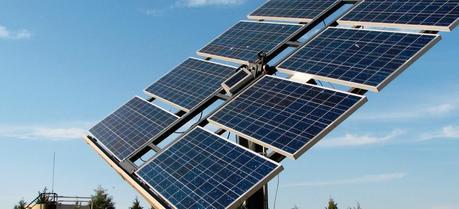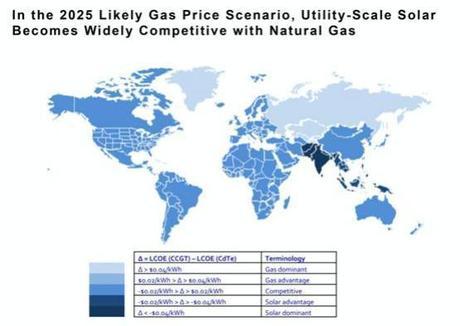
The idea of parity for solar power, the day when power from solar panels costs as much as other electric generation sources like coal or natural gas, is coming closer, but when exactly will we hit that mark? The Department of Energy’s SunShot Initiative seeks to reach that point by the end of this decade—and some other analyst companies see that as possible and have made recent predictions to that effect. But today Lux Research reported it anticipates the world will largely reach solar parity by 2025.
Parity not only means that solar energy is cost-competitive with other energy sources, it means it’s cost-competitive without subsidies. That holds true even if those energy sources are supported by subsidies as coal, nuclear and natural gas still are.
In its new report: “Cheap Natural Gas: Fracturing Dreams of a Solar Future.” Lux Research found that solar will reach parity with natural gas in 10 major regions in 2025, partly because of inexpensive natural gas. Natural gas also is seen as a transitional energy source in the new report. “The levelized cost of energy (LCOE) from unsubsidized utility-scale solar closes the gap with combined cycle gas turbines (CCGT) to within 2 cents per kilowatt hour worldwide in 2025,” Lux said. “Solar’s competitiveness is led by a 39 percent fall in utility-scale system costs by 2030 and accompanied by barriers to shale gas production—anti-fracking policies in Europe and a high capital cost in South America.”

The map shows a forecast of solar energy penetration in 2025. (Source: Lux Research, Inc. http://www.luxresearchinc.com/). Click to enlarge.
“On the macroeconomic level, a ‘golden age of gas’ can be a bridge to a renewable future as gas will replace coal until solar becomes cost competitive without subsidies. On the microeconomic level, solar integrated with natural gas can lower costs and provide stable output,” said lead report author and Lux Research Associate Ed Cahill.
The report also contended that increased natural gas energy generation will benefit solar because it can help enable hybrid gas/solar technologies that can accelerate adoption of solar without expensive infrastructure improvements. One of the reasons for that is natural gas-fired power plants can ramp energy production up and down more easily than coal-fired power plants.
Although Lux Research anticipates that solar will reach mass parity across the world by 2025, certain regions could see parity earlier. “Solar can be competitive with natural gas as early as 2020 if gas prices are between $4.90 per million Btu and $9.30 per MMBtus, depending on the solar resource. In the likely scenario of gas prices above $7.60/MMBtu, solar will be broadly competitive by 2025 in all 10 regions,” Lux said.
However to reach that goal the installed price of solar at the utility-scale must fall to $1.20 per watt from the $1.93 per watt that Lux Research observed in 2013. The lowered price per watt, according to Lux will be driven by PV module efficiency gains and will be led by thin-film utility scale solar. Much like the past few years for solar, Lux Research anticipates that solar’s growth into a competitive energy source will be rough. “Turmoil is imminent because standalone solar will not yet be competitive when subsidies start expiring in markets like China, the U.S. and Japan,” Lux said. “Companies will need to diversify geographically and transition to areas with fewer gas resources–or develop hybrid systems that take advantage of low gas prices.”
That’s just one opinion, however, other analysts have seen solar coming into parity in an increasing number of places across the world. For instance, earlier this year Deutsche Bank analyst Vishal Shah anticipated that an increasing number of world markets would come into solar parity in the next three to five years. And the SunShot Initiative aims to reduce the installed cost of rooftop solar to 6 cents per kilowatt hour for solar rooftops by 2020, making it cost-competitive with the price people pay for energy off the grid. Then again the National Renewable Energy Laboratory anticipated that solar and wind will come into parity in 2025 as well.
This article was originally posted on SolarReviews by Chris Meehan.

